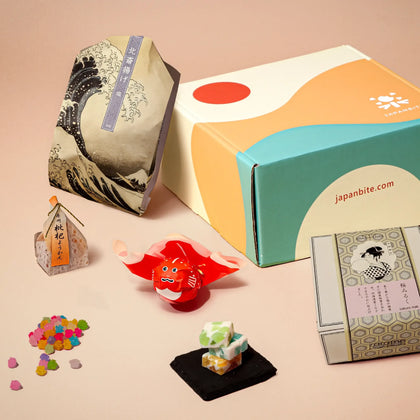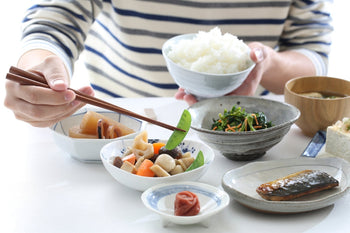

The complex and fascinating culinary history of Japan has become popular all around the world, and nowadays, you can find many Japanese ingredients and even beverages even if you live outside the country. Today we will give you an easy explanation of some of the most famous foods and beverages, starting from their etymology.
Eat in Japanese
The verb “to eat” can be translated to “食べる” (たべる, taberu) in Japanese.
The ideogram “食” has an interesting origin:
- the upper part, 人, represents the act of collecting food and putting a lid on it
- the lower part, 良, refers to the food itself, disposed of in a useful and beautiful way.
Let’s look at some of the main ingredients of Japanese culinary culture: it will allow you to enjoy even more your breakfast, lunch, and dinner in Japan.
Foods in Japanese
Here are some of the main foods and ingredients of Japanese culinary tradition.
Rice in Japanese
- Gohan
"Rice" in Japanese is written as “ご飯” (ごはん, gohan). “飯”(はん, han) means “meal”, while “ご” (go) is an honorific prefix that is often added to the head of a noun, with the purpose of showing politeness and respect both to your interlocutor and the meaning of the noun itself.
- Kome
Whilst "gohan" is usually referred to "ready-to-eat" rice, rice that still needs to be cooked is often called “米” (こめ, kome). Sometimes Japanese also put “お” (o), another honorific expression, forming the word “お米” (おこめ, o-kome).
Japanese rice is known for its firm and sticky texture. Plain rice is present in almost every meal, as it accompanies the main dish, or okazu, together with Japanese pickles and miso soup. But that is not all, Japanese rice can be used in a wide variety of ways: it can be fried, cooked together with vegetables and meat, and can also accompany overseas-originated dishes such as curry and rice. Last but not least, it is also used to make alcoholic drinks like sake (we will talk about it later) and some kinds of tea!

Bread in Japanese
To refer to “bread” in Japanese, you would say “パン” (pan).
This word is derived from the corresponding Portuguese expression “pao”.
Bread was imported to Japan in 1543 when Portuguese mariners arrived for the first time on Okinawa's Tanegashima island. Nowadays, Japan has its unique bread variations that are getting more and more popular around the world: an example is an-pan (“あんパン”), which consists of a sweet, soft milk bread containing red bean paste. Not only is it a tasty sweet, it is an amazing combination of Western and Japanese culinary traditions!
Meat, Fish, Vegetable, and Fruit in Japanese
Let’s now talk about the main ingredients of Japanese cuisine: we recommend you read the article "Meat, fish, vegetable, and fruit in Japanese" for a more detailed explanation.
Meat in Japanese
In Japanese, “meat” is referred to as “肉” (にく, niku).
The main types of meat consumed in Japan include beef, pork, chicken, and sometimes horse meat. Japanese meat is known for its thin and tender texture, especially in the case of wagyu: this term refers to a particular category of beef that must respect several specific conditions. It is one of the most expensive yet high-quality meats around the world.
Fish in Japanese
To refer to “fish” in Japanese, you would say “魚” (さかな, sakana).
Fish is one of the most common ingredients in Japanese meals: almost until the last hundred years, meat was not a significant part of Japanese cuisine. This is due to many factors, such as geographical (remember, Japan is an archipelago!) and religious (eating four-legged animals was considered taboo) reasons. It is interesting how, on the other hand, the Japanese habit of consuming raw fish was surprising to many foreign states!

Vegetable in Japanese
The Japanese term for “vegetable” is “野菜” (やさい, yasai).
It derives from the combination of two ideograms, 野 stands for “field”, while 菜 means ”vegetable” or “side dish”.
Nowadays, many Japanese vegetables are becoming available overseas as well: an example is lotus root, often served boiled with other vegetables.
Fruit in Japanese
“Fruit” is called “果物” (くだもの, kudamono) in Japanese.
This word derives from the union of the two kanji’s 果 (“fruit” in an extended meaning, also comprehending non-edible ones) and 物 (“thing”). Japanese fruits are grown with extreme delicacy and attention, and it is a common habit to give high-quality fruits as a gift.

Spice in Japanese
“Spice” in Japanese is written as “香辛料” (こうしんりょう, koushinryou).
The ideogram “香” means “flavor” or “sweet”, whilst ”辛” means ”spicy”, and “料” means “ingredient”.
The unique taste of Japanese meals, so unusual yet delicious, can be attributed to the presence of numerous spices. The most popular one is for sure the green sauce you can find on sushi and sashimi (but not only!): it is wasabi, a condiment that derives from a plant known as Wasabia japonica. Another popular spice is Shichimi Tōgarashi, a blend of seven condiments including sansho pepper, chili pepper, and sesame.
Drink in Japanese
The verb “to drink” is written as “飲む” (のむ, nomu).
Doesn’t the left half of the ideogram remind you of something? The kanji that stands for “drinking”, in fact, is made of the previously seen ideogram “食” and the ideogram “欠”, which means “opening your mouth really large”!
Some beverages in Japanese
Let’s now talk about some of the most common Japanese beverages.
Water in Japanese
The word for water is “水” (みず, mizu).
Fun fact: this ideogram was first written by looking at the wavy and centrifuge patterns of water!

Hot water in Japanese
The word “お湯” (おゆ, oyu) refers not only to drinkable water but also to thermal water! The ideogram “湯” (ゆ, yu) refers to hot water itself, whilst the term “お” (o) is again an honorific prefix.
Plain drinkable hot water is often called “白湯” (さゆ, sayu), a term that can be directly translated to “white hot water” Hot water is known for its physiological and esthetic properties, and therefore largely suggested both by doctors and beauty experts.
Cold water in Japanese
Cold water is written as “冷水” (れいすい, reisui).
The combination of the two ideograms that compose this term means “cold” (冷, rei) +“water” (水, sui).
Cold water is often served for free in restaurants and cafes, especially during summertime.
Coffee in Japanese
In Japan, you refer to coffee by the term コーヒー (kōhī), a borrowed word from English.
Did you know that coffee is very popular in Japan? Thanks to the influence of Western culture, coffee is nowadays enjoyed both in its hot and iced versions. Many variations like cafe au lait and cappuccino are largely appreciated, too.
Tea in Japanese
To refer to “tea”, you would use the term “お茶” (おちゃ, ocha).
Also in this case, the prefix “お” (o) has an honorific purpose; the ideogram “茶”, pronounced as “cha”, usually means “tea” but not only, and here there is another fun fact: the Japanese expression for “brown” is “茶色” (ちゃいろ, chairo), literally meaning “tea color”!
Tea plays an essential role in Japanese tradition: there are more than 100 types of Japanese tea, and it is drunk even more than water. It is said that the habit of drinking tea daily is one of the secrets of the longevity of Japanese people!
Green tea
Green tea is called “緑茶” (りょくちゃ, ryokucha).
The ideograms of this term mean literally “green tea”.
Green tea is made from Camellia sinensis leaves and has a unique dark green color. Its characteristic grassy flavor is due to the steaming process it undergoes during its production. It is the most common kind of Japanese tea.

Roasted green tea
Roasted green tea is known as “ほうじ茶” (ほうじちゃ, houjicha).
This word literally means “roasted tea”.
As the name suggests, the houjicha tea leaves get roasted instead of being steamed to prevent oxidation, and this allows the production of its peculiar light golden color and “roasted” flavor.

Black tea
Black tea is often written in katakana (which is an alphabet used for foreign and borrowed words) as “ブラックティー” (burakku tī), since it was imported from England (through China).
The correspondent Japanese term, on the other hand, is “紅茶” (こうちゃ, koucha), which means literally “red tea”.
The reason for this difference between the English and the Japanese expression is quite interesting: while English people have named this type of tea after its black desiccated leaves, Japanese tradition considers the color of the “liquid” tea to be the actual color of the tea leaves.
The most famous black tea brand is undoubtedly “午後の紅茶” (ごごのこうちゃ, Gogo no Koucha meaning “Afternoon red tea”): everyone, from children to elders, will immediately its bottles and tea bags!
Oolong tea
Oolong tea is written as “烏龍茶” (ウーロンちゃ, ūloncha).
This term has a fascinating meaning: the ideogram “烏” (“raven”) refers to the black tea leaves, while the kanji “龍”, which means “dragon”, recalls both the curved shape of the oolong leaves and the Chinese emperor from a symbolistic point of view.
Even though oolong tea was originally imported from China, it has become extremely popular in Japan, and today it is often offered in cafes and restaurants because of its refreshing flavor.

Milk in Japanese
Cow milk is usually called “牛乳” (ぎゅうにゅう, gyūnyū).
This term is composed of two ideograms: the first one means “cow”, whilst “乳” means “milk” in its extended way: for example, the Japanese word for soy milk is “豆乳” (とうにゅう, tounyū), with the character “豆” referring to soy.
You can also find the borrowed English form “ミルク” (miruku), especially in fancy cafes: it is considered a more elegant expression, probably because the habit of drinking milk was spread by Dutch immigrants in the XVIII-XIX centuries.
In Japan, it is extremely common to make kids drink cow milk, and not only in their own homes: in fact, it is served daily almost in every kindergarten and elementary school because of its nutritional value.
Soy milk is very popular as well for its nutritional and esthetic properties: you can find in every grocery store an incredible variety of soy milk flavored with fruit, matcha, vanilla, chocolate… and more!
Juice in Japanese
Juice is referred to as “ジュース” (jū-su), another word that derives from an English term.
Japan offers a wide variety of different tastes and combinations, including some extraordinarily vitamin-rich juices containing more than 20 types of vegetables!
Some alcoholic beverages in Japanese
Alcoholic beverages are often called “酒” (さけ), pronounced “sake”.
Although sake is actually a specific kind of drink, this term can be attributed to any type of alcoholic beverage, including Western beer and vine, too!
Beer
Beer is referred to as “ビール” and pronounced “bīru” from the English correspondent word.
Beer is a popular alcoholic drink in Japan. Many Japanese beer brands, such as Kirin and Asahi, are known internationally.
Sake
As said before, the term “酒” (さけ, sake) can refer to any type of alcoholic drink: while talking specifically about Japanese sake, people call it “日本酒” (にほんしゅ, nihonshu), an expression that literally means “Japan” and “alcoholic beverage”.
Sake is an alcoholic beverage that derives from fermented rice, also known as “rice vine”.

Shōchū
Shōchū is written as “焼酎” (しょうちゅう).
It literally means “burned liquor”, due to the characteristic heating process during its distillation.
Shōchū is a category of Japanese alcoholic beverages that are typically distilled from barley, sweet potatoes, rice, or even chestnuts. Shōchū contains about 25% alcohol by volume.
Here are some of the main foods and beverages of Japanese culinary culture: while it might seem quite complicated, we hope that understanding the history and traditions of each ingredient will allow you to enjoy your discovery of this incredible variety of Japanese meals and drinks even more!





